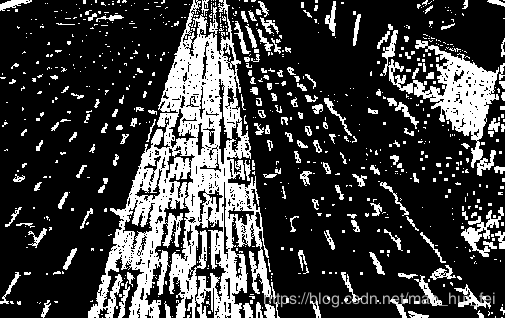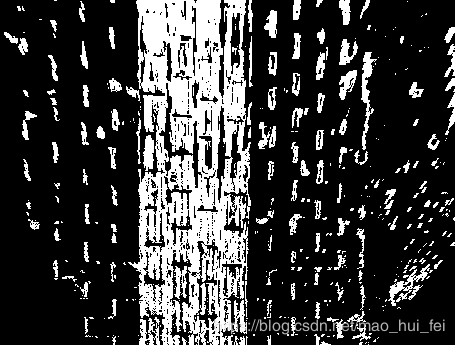


def thresholding(img):
# setting all sorts of thresholds
# 计算x轴方向或y轴方向的颜色变化梯度导数,并以此进行阈值过滤(thresholding),得到二进制图(binary image):
# x_thresh = utils.abs_sobel_thresh(img, orient='x', thresh_min=10 ,thresh_max=230)#通过调整阈值,获取清晰的车道线
x_thresh = utils.abs_sobel_thresh(img, orient='x', thresh_min=40, thresh_max=230) # 通过调整阈值,获取清晰的车道线
x_thresh_o = np.uint8(255 * x_thresh / np.max(x_thresh))
cv2.namedWindow('x_thresh', 0) # 窗口大小可以改变
cv2.imshow("x_thresh", x_thresh_o)
cv2.waitKey(10)
# OpenCV定义的结构元素
kernel0 = cv2.getStructuringElement(cv2.MORPH_RECT, (1, 1))
kernel00 = cv2.getStructuringElement(cv2.MORPH_RECT, (2, 2))
kernel = cv2.getStructuringElement(cv2.MORPH_RECT, (3, 3))
kernel1 = cv2.getStructuringElement(cv2.MORPH_RECT, (11, 11))
kernel2 = cv2.getStructuringElement(cv2.MORPH_RECT, (7, 7))
# # 腐蚀图像
# eroded0 = cv2.erode(x_thresh_o, kernel00)
# # 显示腐蚀后的图像
# cv2.namedWindow('Eroded0', 0) # 窗口大小可以改变
# cv2.imshow("Eroded0", eroded0);
# 膨胀图像
dilated = cv2.dilate(x_thresh_o, kernel2)
dilated_o = np.uint8( dilated /255 )
cv2.namedWindow('dilated', 0) # 窗口大小可以改变
cv2.imshow("dilated", dilated);
# pimg = Image.fromstring("RGB", cv2.GetSize(dilated), dilated.tostring()) # pimg is a PIL image
# dilated0 = np.array(pimg) # array is a numpy array
# dilated_0 = np.uint8(255 * dilated / np.max(dilated))
# dilated_1 = np.uint8(255 * dilated_0 / np.max(dilated_0))
# cv2.namedWindow('dilated', 0) # 窗口大小可以改变
# cv2.imshow("dilated", dilated);
# cv2.namedWindow('dilated_0', 0) # 窗口大小可以改变
# cv2.imshow("dilated_0", dilated_0);
# cv2.namedWindow('dilated_1', 0) # 窗口大小可以改变
# cv2.imshow("dilated_1", dilated_1);
# # 显示膨胀后的图像
# cv2.namedWindow('Dilated', 0) # 窗口大小可以改变
# cv2.imshow("Dilated", dilated);
# # Copy the thresholded image.
# im_floodfill = dilated.copy()
# Mask used to flood filling.
# Notice the size needs to be 2 pixels than the image.
# h, w = dilated.shape[:2]
# mask = np.zeros((h + 2, w + 2), np.uint8)
#
# # Floodfill from point (0, 0)
# cv2.floodFill(im_floodfill, mask, (0, 0), 255);
#
# # Invert floodfilled image
# im_floodfill_inv = cv2.bitwise_not(im_floodfill)
#
# # Combine the two images to get the foreground.
# im_out = dilated | im_floodfill_inv
# # 显示腐蚀后的图像
# cv2.namedWindow('im_out', 0) # 窗口大小可以改变
# cv2.imshow("im_out", im_out);
# # 腐蚀图像
# eroded = cv2.erode(im_out, kernel1)
# # 显示腐蚀后的图像
# cv2.namedWindow('Eroded', 0) # 窗口大小可以改变
# cv2.imshow("Eroded", eroded);
mag_thresh = utils.mag_thresh(img, sobel_kernel=3, mag_thresh=(50, 150))
mag_thresh_o = np.uint8(255 * mag_thresh / np.max(mag_thresh))
# cv2.namedWindow('mag_thresh', 0) # 窗口大小可以改变
# cv2.imshow("mag_thresh", mag_thresh_o)
# cv2.waitKey(10)
dir_thresh = utils.dir_threshold(img, sobel_kernel=3, thresh=(0.7, 1.3))
dir_thresh_o = np.uint8(255 * dir_thresh / np.max(dir_thresh))
# cv2.namedWindow('dir_thresh', 0) # 窗口大小可以改变
# cv2.imshow("dir_thresh", dir_thresh_o)
# cv2.waitKey(10)
#hls_thresh = utils.hls_select(img, thresh=(25, 30))
hls_thresh = utils.hls_select(img, thresh=(16, 22))
hls_thresh_o = np.uint8(255 * hls_thresh / np.max(hls_thresh))
# cv2.namedWindow('hls_thresh', 0) # 窗口大小可以改变
# cv2.imshow("hls_thresh", hls_thresh_o)
# cv2.waitKey(10)
lab_thresh = utils.lab_select(img, thresh=(121, 125))
lab_thresh_o = np.uint8(255 * lab_thresh / np.max(lab_thresh))
# cv2.namedWindow('lab_thresh', 0) # 窗口大小可以改变
# cv2.imshow("lab_thresh", lab_thresh_o)
# cv2.waitKey(10)
lab_thresh_0 = cv2.dilate(lab_thresh_o, kernel)
lab_thresh_1 = np.uint8(lab_thresh_0 / 255)
# cv2.namedWindow('lab_thresh_0', 0) # 窗口大小可以改变
# cv2.imshow("lab_thresh_0", lab_thresh_0);
luv_thresh = utils.luv_select(img, thresh=(225, 255))
luv_thresh_o = np.uint8(255 * luv_thresh / np.max(luv_thresh))
# cv2.namedWindow('luv_thresh', 0) # 窗口大小可以改变
# cv2.imshow("luv_thresh", luv_thresh_o)
# cv2.waitKey(10)
# Thresholding combination
threshholded = np.zeros_like(x_thresh)
threshholded1 = np.zeros_like(x_thresh)
threshholded2 = np.zeros_like(x_thresh)
threshholded3 = np.zeros_like(x_thresh)
threshholded4 = np.zeros_like(x_thresh)
threshholded5 = np.zeros_like(x_thresh)
threshholded[((dilated_o == 1) & (mag_thresh == 1)) | ((dir_thresh == 1) & (hls_thresh == 1)) | (lab_thresh == 1) | (
luv_thresh == 1)] = 1
#滞留lab和luv
threshholded1[(lab_thresh == 1) &(luv_thresh == 1)] = 1
threshholded5[((lab_thresh == 1) &(luv_thresh == 1))|((dilated_o == 1) &(luv_thresh == 1))] = 1
#
#threshholded2[(dilated == 1) & (lab_thresh == 1)| (luv_thresh == 1) ] = 1
threshholded2[dilated_o == 1] = 1
threshholded3[(dilated_o == 1) & (lab_thresh == 1)| (luv_thresh == 1) ] = 1
threshholded4[(dilated_o == 1) & (lab_thresh_1 == 1) | (luv_thresh == 1)] = 1
threshholded_3o = np.uint8(255 * threshholded3 / np.max(threshholded3))
threshholded_o = np.uint8(255 * threshholded / np.max(threshholded))
threshholded_1o = np.uint8(255 * threshholded1 / np.max(threshholded1))
threshholded_2o = np.uint8(255 * threshholded2 / np.max(threshholded2))
threshholded_4o = np.uint8(255 * threshholded4/ np.max(threshholded4))
threshholded_5o = np.uint8(255 * threshholded5 / np.max(threshholded5))
cv2.namedWindow('threshholded_4o', 0) # 窗口大小可以改变
cv2.imshow("threshholded_4o", threshholded_4o)
cv2.waitKey(10)
# cv2.namedWindow('threshholded_o', 0) # 窗口大小可以改变
# cv2.imshow("threshholded_o", threshholded_o)
# cv2.waitKey(10)
# cv2.namedWindow('threshholded_1o', 0) # 窗口大小可以改变
# cv2.imshow("threshholded_1o", threshholded_1o)
# cv2.waitKey(10)
# cv2.namedWindow('threshholded_2o', 0) # 窗口大小可以改变
# cv2.imshow("threshholded_2o", threshholded_2o)
# cv2.waitKey(10)
# cv2.namedWindow('threshholded_3o', 0) # 窗口大小可以改变
# cv2.imshow("threshholded_3o", threshholded_3o)
# cv2.waitKey(10)
#
# cv2.namedWindow('threshholded_5o', 0) # 窗口大小可以改变
# cv2.imshow("threshholded_5o", threshholded_5o)
# cv2.waitKey(10)
# cv2.waitKey(10)
return threshholded4


